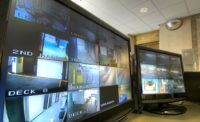VIDEO SOLUTIONS
Sorting Through the Jargon of Video Storage
Understanding the common — and not-so-common — terms and acronyms in the video storage space is the first step to mastering the technology.

IMAGE COURTESY OF BCDVIDEO
Depending on the hardware, software, architecture, network and other factors, there are many variations of video surveillance storage, all of which are described with some industry-specific terminology.

IMAGE COURTESY OF BCDVIDEO

IMAGE COURTESY OF BCDVIDEO



When discussing video storage technologies and products, there are many acronyms and terms that are thrown around. But what, exactly, do they mean? Some, such as NAS and DAS, may be more familiar; while others, such as HCI and NVME, may be less so. Beyond simple definitions, the larger question is, “What do they mean when it comes to sales, installation, deployment and maintenance?”
Knowledge is power, so in an effort to compile a comprehensive video storage glossary, SDM spoke with several industry insiders in the storage space. This comprehensive list, which covers a wide variety of terms and concepts, is the result of those conversations.
Appliance: A server preloaded with software that is built for use with a specific application.
Bare metal server: A server with one operating system, operating on its own amongst other servers.
DAS (direct attached storage): Not technically a shared storage technology, but used often by IT departments to describe an external set of drives connected to a server to expand that server’s total capacity. DAS also can be used interchangeably to describe the storage inside of a standard server.
DDP (dynamic disk pooling): Used to distribute data, spare capacity and protection information across a pool of disk drives. It is becoming more widely used, as it aids in pool rebuilding process and can more ably adapt itself to larger DDP sizes when adding more disks to the pool. In general, DDP can be viewed as another level of RAID, but with many benefits. In time, this is likely to overtake RAID configurations.
Disk pooling: Aggregates disks into one logical group, similar to RAID, but offers greater load balancing and scales better with larger capacity drives as disk rebuild time is reduced compared to a RAID array.
Erasure coding: An alternative to RAID, erasure coding is a software-based method of achieving data redundancy, where data is stored in multiple places throughout an infrastructure. The goal of erasure coding is to allow data that has become corrupted at some point in the storage process to be reconstructed using information about the data that is stored in other locations within the storage array. Compared to RAID, erasure coding reduces the time and overhead required to reconstruct data. One drawback is that erasure coding can be more CPU-intensive, which can lead to increases in latency.
HCI (hyper-converged infrastructure): A software-defined storage platform combined with virtualized servers on a singular hardware solution as a means of reducing complexity. HCI gives users the ability to run multiple servers and large-scale shared storage without the cost and complexity of traditional datacenter infrastructure. As a hardware-based model, HCI allows end users to easily scale storage, computing power and/or graphics processing as needed by adding additional pre-configured appliances to a solution.
Putting Jargon Into Practice
“It’s important to understand how or where the storage devices are, as with SAN and NAS for example, they may not necessarily be in the same room with the recording software. Also, keep in mind that SANs usually are connected via fiber channels and NASs are connected via typical Ethernet cables. In addition, there are the differences of block level or file-level recording.” — Troy Wideman, regional marketing manager, Bosch Security and Safety Systems
“Storage can be a tricky animal because there are so many different types of storage, as well as the very important factor of what is being stored. In the world of video surveillance storage, the sheer size of the video data being stored can have a significant effect on the cost of the overall project. Some of the important storage factors to take into consideration are the length of time the video surveillance data is being stored, the image resolution and frame rate, the compression technology being used, and the location of the storage. In many cases, the location dedicates the storage technology that will be used.” — Keith Drummond, senior director of sales, IDIS America
“Software-defined storage and HCI are emerging as viable alternatives for hosting VMS and analytics applications as well as storing video data. Users and integrators should be aware, however, that not all software-defined storage and HCI is the same, and it’s important to consider technologies that are designed with the unique needs of video in mind.” — Brandon Reich, vice president, product and strategy, Pelco
“Some customers have no tolerance for camera or recording downtime because they’re in a position where video is mission-critical to them. They need resiliency, which means the system can recover quickly and continue operating even when there’s some sort of failure. And if there’s one thing you can guarantee with all this advanced technology we have, it’s that at some point, things are going to fail. So you have to ask, what are the resiliency requirements based on the customer’s environment, and how are you going to achieve that? And what does the technology, be it RAID or erasure coding, or a clustered architecture give you from a resiliency standpoint?” — Mike Koponen, senior director, product and solutions marketing, Pivot3
HDD (hard disk drive): A fixed drive using electro-mechanical and magnetic storage techniques. Often referred to as a platter-based drive, HDD is the most commonly used drive type for storing video data because of large storage requirements and costs. HDD incorporates 3.5-in. or 2.5-in. spinning disks and typically offers the highest capacity (up to 16TB) and lower cost per gigabyte than SSD, but slower read and write speeds.
Hot-swappable: A peripheral or component that can be removed or added while a computer is running. Replacing a device while a computer is powered on is called hot swapping.
Hyper scale: Traditionally needed in large-scale data centers, “big data” applications, or cloud computing, offers scalability to drastically increase performance and storage while maintaining resiliency as needed.
iSCSI (Internet small computer systems interface): An IP-based protocol for linking data storage devices and/or facilities. It is used to make connections and transmit data over the network to storage devices.
JBOD (just a bunch of disks): Slang term for “spanning,” which refers to a computer’s hard disks that haven’t been configured according to the RAID system to increase fault tolerance and improve data access performance.
LAN (local area network): A network that interconnects devices within certain boundaries such as a home, school, or office building.
NAS (network attached storage): A single device or appliance deployed as a file server that connects to a network and shares storage over the network and provides access to a group of clients. NAS is typically the lowest-cost shared storage technology but sacrifices reading and writing speed, as well as latency. Because of this trade-off, NAS is best suited for long-term retention of video that is not necessarily accessed regularly.
NVME (non-volatile memory express): A storage protocol utilizing the PCIe (peripheral component interconnect express) bus created to provide extremely fast reading and writing.
RAID (redundant array of independent disks): Used to combine multiple disk drives into one or more logical units in order to achieve data redundancy. There are multiple versions of RAID, which offer differing levels of data protection and read/write performance. However, the most commonly used RAID in video surveillance are RAID 5 (protects data against the loss of one drive in a group) and RAID 6 (protects data against the loss of two drives in a group simultaneously).
SAN (storage area network): A network of switches, hosts, and storage devices on a network. Using a SAN means that data is stored at the block level without the overhead of a file system, allowing solutions to read and write video and data much faster than NAS. SAN is best suited for video applications that are continuously streaming a great amount of video from a large number of cameras simultaneously, and can also be effective (though not always as cost-efficient) for long-term video retention.
SATA (serial advanced technology attachment): An interface used to connect ATA (or PATA) hard drives to a computer’s motherboard. SATA transfer rates start at 150MBps, which is significantly faster than even the fastest 100MBps ATA/100 drives. For this and other reasons, Serial ATA is likely to replace the previous standard, Parallel ATA (PATA), which has been around since the 1980s.
Software-defined storage: Typically used to describe a shared storage platform (for example, NAS or SAN) that eliminates the need for dedicated storage hardware by using “groups” of standard servers with internal DAS storage and aggregating that storage together with specialized software. A software-defined storage platform will look just like a standard NAS or SAN to an application, but typically costs less to acquire and deploy. Because it is based on software instead of dedicated hardware, this type of storage also has the benefit of being changed, updated or optimized to fit a user’s specific needs.
SSD (solid-state drive): A fixed drive using integrated circuits usually called flash memory to store data. Compared to HDD, SSD offers faster read and write speeds and lower utilization. Drawbacks include much lower capacities and higher cost per gigabyte, although these factors are changing rapidly. SSD are most often used to run applications that require fast performance, such as a server operating system or VMS database, while video data is actually stored on higher-capacity HDD.
Virtualization: A storage concept achieved by employing software known as hypervisors, virtualization is the process of presenting a logical view of physical storage resources, treating all storage media as a single pool of storage.
WAN (wide area network): A network that interconnects devices over large areas and distances.
Zero-point to failure: The concept of having full hardware redundancy within a chassis, often requiring redundant power supplies and redundant RAID controllers within the chassis.
More Online
For more on video storage, visit SDM’s website where you will find the following articles.
“6 Keys to Successful Video Storage”
www.SDMmag.com/6-keys-successful-video-storage
“3 Main Ingredients for Video Storage Success”
www.SDMmag.com/3-ingredients-video-storage-success
“Feeding the Growing Appetite for Video Surveillance Data”
Looking for a reprint of this article?
From high-res PDFs to custom plaques, order your copy today!











